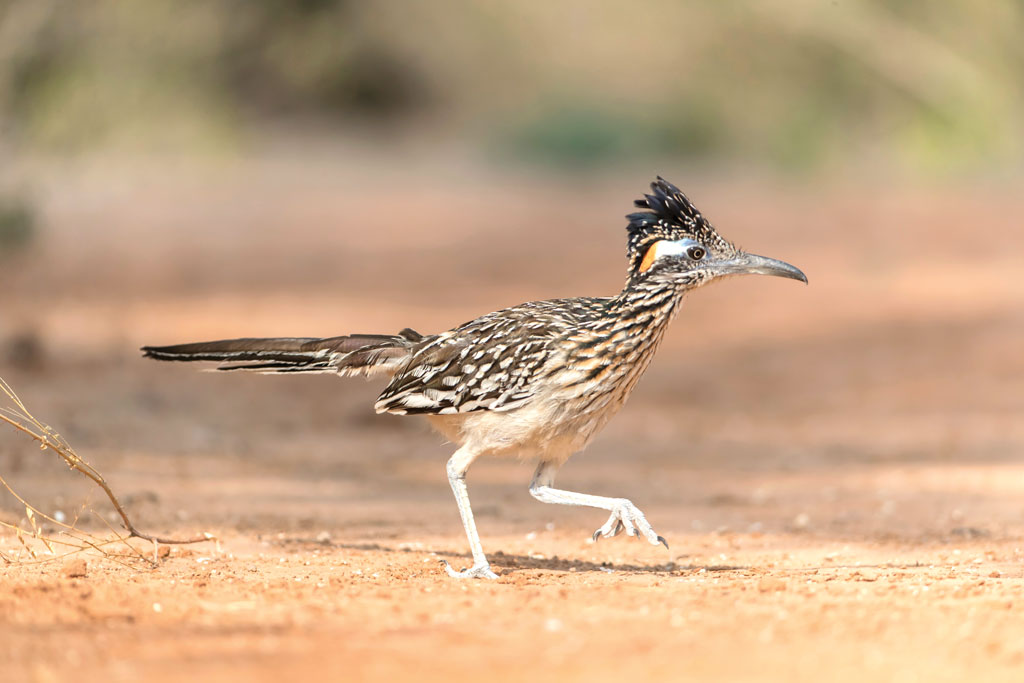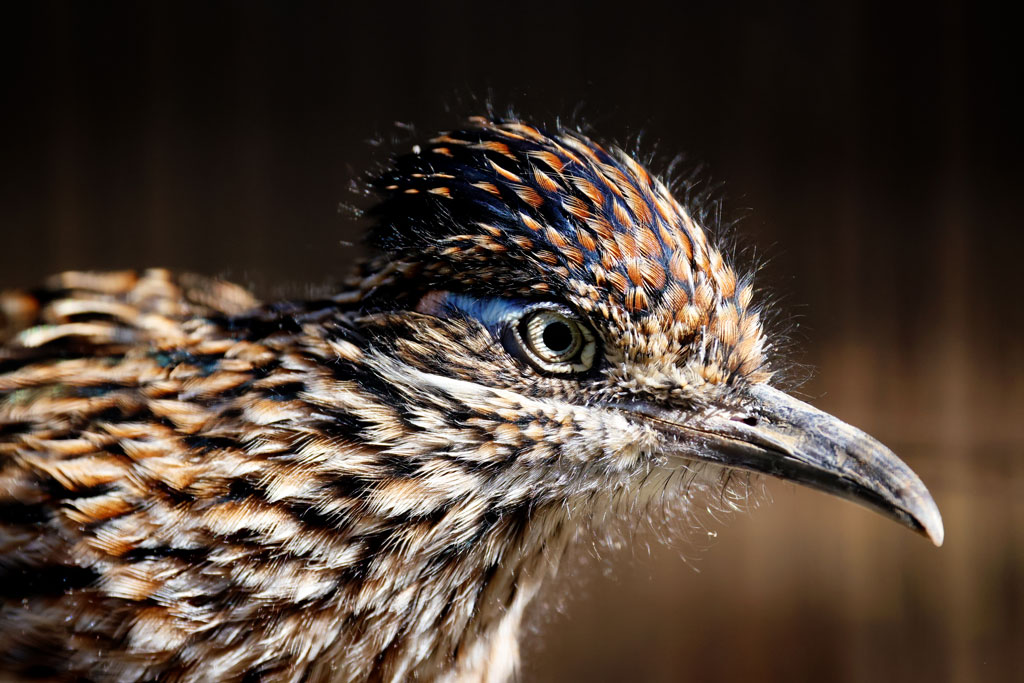
Though a roadrunner spotting might make you want to say ‘meep-meep,’ the ground bird actually coos, clucks, or rattles. It is a member of the cuckoo family.
In a flock by itself, the greater roadrunner, also called a chaparral cock or paisano, is one of the most easily recognizable birds in the Hill Country. As rugged as the terrain in which it thrives, this native Texan is one tough bird, well known for its preference of traveling by foot rather than wing. The roadrunner is a clever, highly adaptable ground bird that can easily outrun a human, get cozy in a clump of cacti, and make a meal out of a rattlesnake.
LONG, TALL TEXAN
Twice as long as it is tall (at about 12 inches) and weighing around a pound, the roadrunner is a curious creature. Its distinct appearance includes a black crest atop its head used for communication, an elongated neck (not as much as the cartoon version) useful for catching prey, a lengthy tail for balance, steering, and breaking, and long, strong road-running legs with zygodactyl feet (two toes forward, two toes back) for climbing and grasping. Behind each eye is skin in colored patches of blue, white, and red-orange that is often hidden by feathers. Roadrunners have an overall dark brown, streaky appearance, and males and females look alike.

As members of the cuckoo family, roadrunners do not “meep-meep.” Rather, they “coo-cooo-cooo-coooooo.” They also cluck and do a mean bill rattle reminiscent of a woodpecker when alarmed. The males make a whirring sound during mating season.
ADAPTABLE ANIMAL
The roadrunner is highly adaptable and can live anywhere with open areas for feeding and vegetation for roosting and nesting. It can only fly in short bursts that look more like flying hops. What it lacks in wing strength is made up for in leg strength. A roadrunner can hit a sprint of 15-25 mph when pursuing prey or escaping predators.
Typically active in the morning and late afternoon, roadrunners will forage at dusk on very hot days. They cool down by panting and puffing up their feathers, exposing bare patches of skin under the chin and on the back — the bird version of sticking a leg out from under the covers at night.
To stay warm in winter, roadrunners expose their bare patches and sunbathe. Most of their water intake comes from their diet. Water is conserved by secreting excess salt from special glands in front of the eyes instead of through the urinary tract, which uses more water. Water is also reabsorbed during digestion. Energy is conserved by resting in the shade on hot days and through torpor, allowing the bird’s body temperature and metabolic activity to significantly decrease at night.
S-S-SNAKES FOR SUPPER
Like its animated nemesis, the coyote, the roadrunner is an opportunistic omnivore. It seems to prefer snakes and lizards but will dine on what’s available, including insects, small mammals, other birds, eggs, carrion, and prickly pear fruit.
If the meal is larger than the gullet, it’s not uncommon for a scaled tail to dangle from a roadrunner’s beak during digestion, which could take several hours.

When wrestling a rattler, the bird circles the snake for distraction before charging and repeatedly pecking its head. Once the meal has been subdued, it is time to tenderize it by pounding it on the ground until the head is crushed and the bones broken.
Roadrunners will team up when tackling larger prey. They are not immune to snake venom and, if bitten, could become the snake’s meal. Predators of the roadrunner include the usual suspects: raccoons, hawks, and, of course, coyotes.
THEY DO! FOR LIFE
Male and female roadrunners take their vows seriously, usually for life, reuniting each breeding season to produce one to three broods every year. The courtship begins around March when the male presents the female with a gift of food, a twig, or grass. After a little tail wagging, crest flexing, bowing, and a short chase, they become a pair.
The female builds a low nest with materials provided by the male. She lays two to eight eggs over the course of several days, which both parents take turns incubating for the next 20 days. The two tag-team feeding and guarding the hatchlings for the next three weeks or so. Once out of the nest, the young stay near their parents until they are self-sufficient.
Roadrunners are highly territorial, solitary birds that live alone. Mates will share and defend one territory but typically not as a pair, except for breeding and family seasons.
FAST FEATHERED FACTS
- A roadrunner footprint forms an X: two toes face forward and two backward, which makes it hard to determine direction of travel when tracking.
- Roadrunners do not migrate. That would be a very long walk.
- The roadrunner is honored in Native American culture for its courage, speed, and endurance. Its X-shaped footprint is a sacred symbol.
- The only two species of roadrunners in the world are the greater roadrunner and the lesser roadrunner. The greater roadrunner is the state bird of New Mexico.
- Roadrunners have been found in every county in Texas.
- A roadrunner’s territory extends about a half-mile and is often shared and defended with a mate.
- The roadrunner is one of the last birds to be protected in Texas because it was once believed the species was responsible for a declining quail population.
- The 120-million-year-old fossilized remains of a roadrunner-like dinosaur were found in China in 2010.












